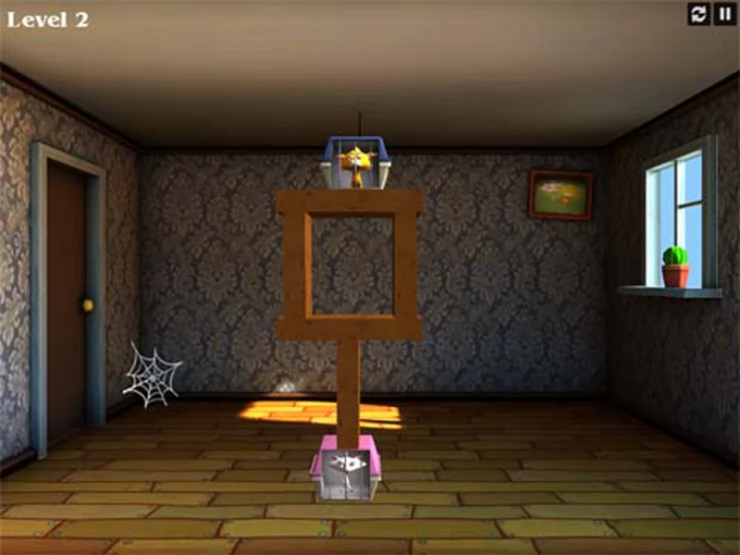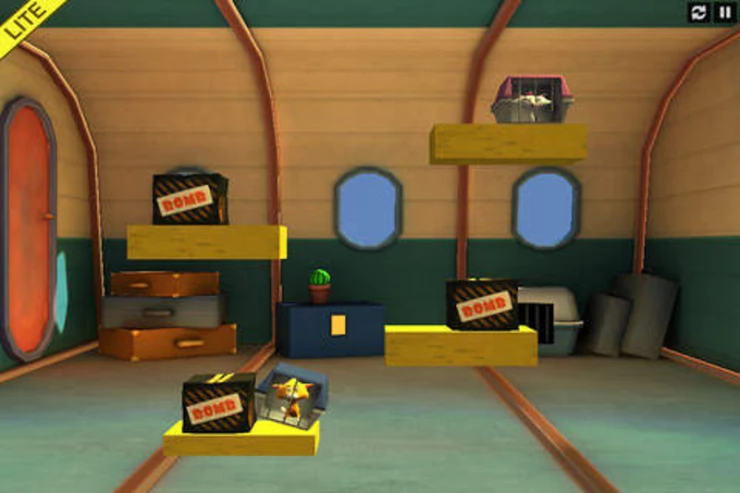Basic Strategy, Hints, and Tips
Crazy Cats Love Guide
The Basic Pieces
Before you progress too far into the game you need to recognize the different puzzle pieces and grok what they do - because they are not all the same.
Brown Pieces: Can be removed, or used as levers, weights, or other actions as allowed by the puzzle.
Yellow Pieces: Removable but fixed pieces that hold other (brown) pieces in place at the start of the puzzle. The Yellow Pieces generally have strategic uses - but the player has to work out how that applies to the specific puzzle, as it changes from puzzle to puzzle.
White Pieces: These are fixed (not removable) in the game, and are often used as impediments.

Tapping and the Timer
Depending upon the difficulty in appearance of a puzzle you might think that finding the fewest number of taps will be the biggest issue in achieving a max score, but believe it or not the timer is usually what messes you up!
With the more complicated puzzles it is a good idea to work through the logic a few times, replaying as often as needed, until you have worked out the best path that you can take to do the puzzle in the shortest amount of time as possible - because that timer is your arch enemy in terms of getting really good scores!
The Luck Factor
While this is largely a game that is based upon a combination of mental quickness and deftness of hand combined with a good eye for puzzle solving, not all of the puzzles are created equally. That is to say you will find that certain puzzles - Number 16 is a perfect example - are down to luck in terms of getting a perfect score.
Using Puzzle 16 as the example, there are only three moves to be made - removing the first and second Yellow Pieces to allow the carrier to slide down, then removing the left-hand Brown Piece to create a ramp that the carrier can fall onto and slide down.
Get that accomplished and have the carriers touch in 6 or fewer seconds and you get 3-Stars - but to get perfect it has to happen in 5 or fewer, and that is where luck becomes a serious issue because there is NOTHING you can do other than get lucky to make that happen.
Seriously. Luck. But the good news is, in cases where luck really is a factor, if you repeat the puzzle eventually you WILL get lucky. It is called the Law of Averages and it is your best mate!

Monster Size Strategy
The fact that this game is so large (130 levels) can be a bit intimidating when you are a perfectionist and want to get perfect 4-Star Scores on all puzzles. Fortunately the game is divided into 7 Sections, each with its own set of puzzles (for example the first Section has 20 Puzzles in it).
That means instead of trying to focus on redo's for all 130 Puzzles, you can work on each Section on its own. Better for managing the overall annoyance of so many Not-4-Star Puzzles, right?
Of course that doesn't just help with the annoyance of keeping them organized in your head because each of the new sections introduces some sort of new element into the puzzle process. For example when you get to Section 2 you will find motorized objects - like the giant fans - have been added to the process of solving a puzzle.
If at First You Don't Succeed
Speaking strategically if you have given a puzzle 8 or 10 really good tries and you failed to get all 4-Stars, move on! Work your way through the game, complete more (and harder) puzzles, and you often find the solution that is eluding you in the experiences you have with those harder puzzles.
The why of that is simple - very often the solution to a puzzle that eludes you is not in the puzzle but in how you approach it - and the wide variety of situations teaches you how to make a LOT of different approaches!
This game is about logic and understanding things like inertia, momentum, and basic physical principles of objects and how they relate to each other in a physical setting. It is widely thought to be a pretty good tool for the practice of problem solving - after all that is really what you are doing when you complete each puzzle...